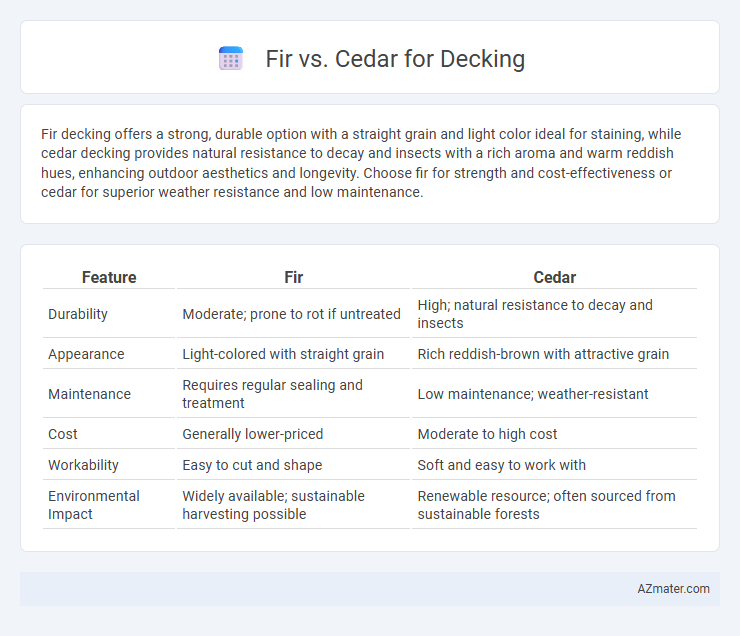Fir decking offers a strong, durable option with a straight grain and light color ideal for staining, while cedar decking provides natural resistance to decay and insects with a rich aroma and warm reddish hues, enhancing outdoor aesthetics and longevity. Choose fir for strength and cost-effectiveness or cedar for superior weather resistance and low maintenance.
Table of Comparison
| Feature | Fir | Cedar |
|---|---|---|
| Durability | Moderate; prone to rot if untreated | High; natural resistance to decay and insects |
| Appearance | Light-colored with straight grain | Rich reddish-brown with attractive grain |
| Maintenance | Requires regular sealing and treatment | Low maintenance; weather-resistant |
| Cost | Generally lower-priced | Moderate to high cost |
| Workability | Easy to cut and shape | Soft and easy to work with |
| Environmental Impact | Widely available; sustainable harvesting possible | Renewable resource; often sourced from sustainable forests |
Introduction to Fir and Cedar Decking
Fir decking offers a strong, durable option with a fine, straight grain and reddish hue, making it popular for structural applications where stability is key. Cedar decking is renowned for its natural resistance to rot, decay, and insect damage, featuring a warm color palette and aromatic scent that enhances outdoor living spaces. Both fir and cedar provide unique aesthetic qualities and durability factors essential for long-lasting, attractive decks.
Key Differences Between Fir and Cedar
Fir offers a harder and more durable option for decking due to its dense grain and resistance to wear, making it ideal for high-traffic areas. Cedar, on the other hand, excels in natural resistance to rot, decay, and insect damage because of its inherent oils, resulting in lower maintenance requirements. While fir generally requires sealing and treatment to prevent moisture damage, cedar's natural stability reduces warping and cracking, enhancing its longevity in outdoor environments.
Appearance and Aesthetics
Fir decking features a light, uniform color with subtle grain patterns that create a clean and modern look, enhancing contemporary outdoor spaces. Cedar offers a rich, reddish-brown hue with pronounced knots and grain variations, providing a warm and rustic aesthetic that deepens over time due to natural weathering. Both woods can be stained or sealed to maintain or alter their appearance, allowing customization to suit various design preferences and outdoor environments.
Durability and Longevity
Fir decking offers moderate durability with a lifespan of around 10 to 15 years when properly maintained, but it is more susceptible to rot and insect damage compared to cedar. Cedar is highly valued for its natural resistance to decay, insects, and weathering, providing superior longevity typically ranging from 20 to 30 years with minimal maintenance. The high tannin content in cedar enhances its durability, making it an ideal choice for outdoor decking applications exposed to moisture and varying climates.
Resistance to Weather and Decay
Fir offers moderate resistance to weather and decay but requires regular sealing and maintenance to prevent warping and rot over time. Cedar naturally contains oils that provide superior resistance to moisture, decay, and insect damage, making it an ideal choice for decking exposed to harsh weather. The durability of cedar reduces the need for frequent treatments, ensuring a longer-lasting and low-maintenance decking surface.
Maintenance Requirements
Fir decking requires regular sealing and staining to prevent moisture damage and prolong its lifespan due to its moderate natural resistance to decay. Cedar naturally contains oils that help resist rot, insects, and moisture, significantly reducing the frequency of maintenance compared to fir. Choosing cedar for decking minimizes the need for frequent treatments and helps maintain aesthetic appeal with less effort over time.
Cost Comparison of Fir vs Cedar
Fir decking generally costs less than cedar, with fir priced around $2 to $4 per square foot compared to cedar's $4 to $7 per square foot depending on grade and region. Fir is more affordable due to its faster growth rate and wider availability, making it a budget-friendly choice for large projects. Although cedar has a higher upfront cost, it offers better natural resistance to rot and insects, potentially reducing long-term maintenance expenses.
Environmental Impact and Sustainability
Fir decking is often sourced from fast-growing trees, making it a more renewable option with a lower carbon footprint compared to slow-growing hardwoods. Cedar, naturally resistant to decay and insects, reduces the need for chemical treatments, contributing to a healthier environment. Both woods vary in sustainability depending on sourcing practices, with FSC-certified fir and cedar ensuring responsible forest management.
Best Applications for Fir Decking
Fir decking excels in structural applications due to its strength, stability, and fine grain, making it ideal for frameworks, joists, and beams under heavy loads. Its moderate resistance to decay suits covered or elevated decks where moisture exposure is limited, while its smooth finish supports paint or stain adherence for aesthetic customization. Fir's cost-effectiveness and availability favor large-scale construction projects requiring durable, dimensionally stable wood with low maintenance demands.
Best Applications for Cedar Decking
Cedar decking excels in outdoor applications where natural resistance to rot, decay, and insect damage is paramount, making it ideal for patios, balconies, and poolside decks. Its dimensional stability and rich, warm color enhance aesthetic appeal while minimizing warping and splitting in variable weather conditions. Cedar is especially suited for environments with high humidity or frequent rain, providing long-lasting durability with minimal maintenance compared to fir.

Infographic: Fir vs Cedar for Decking
 azmater.com
azmater.com